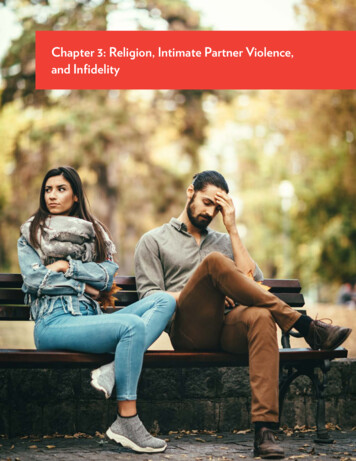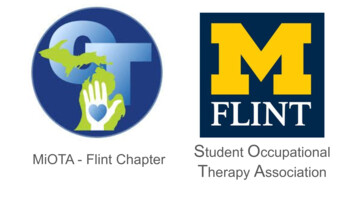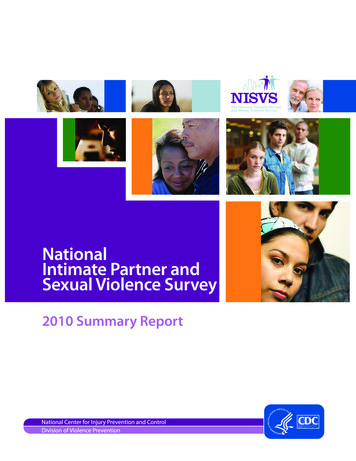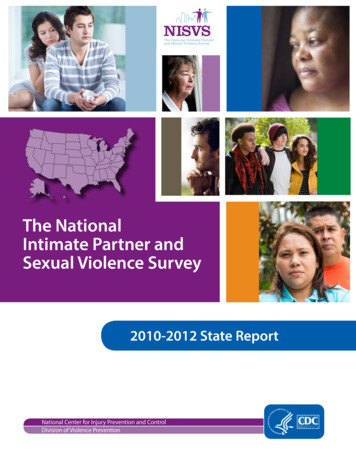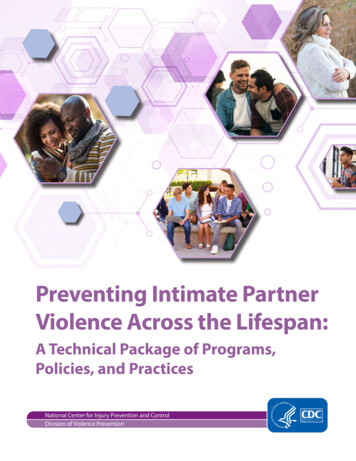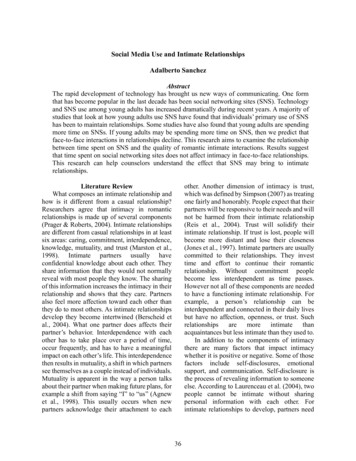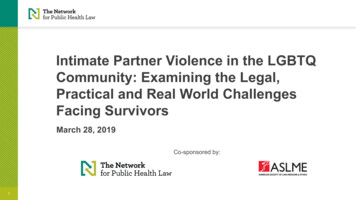
Transcription
Intimate Partner Violence in the LGBTQCommunity: Examining the Legal,Practical and Real World ChallengesFacing SurvivorsMarch 28, 2019Co-sponsored by:1
How to Use WebEx Q & A1. Open the Q&A panel2. Select “All Panelists”3. Type your question4. Click “Send”2
ModeratorGabrielle Shirley, Staff Attorney, the Network for PublicHealth Law – Eastern Region Office J.D., University of Maryland School of Law Research interests/areas of expertise: Interpersonal violence Opioid dependency Injury prevention3
PresenterCatherine Shugrue dos Santos, Deputy ExecutiveDirector for Programs, the New York City Anti-ViolenceProject M.S., Columbia University Research interests/areas of expertise: 4Anti-violence and anti-oppression workReproductive and economic justiceEquity for LGBTQ communitiesHIV
PresenterJennifer Mercer, Baltimore County POARP Staff Attorney, the Women's LawCenter of Maryland J.D., University of Maryland School of Law Research interests/areas of expertise: LGBTQ health and intimate partner violence Protection Order advocacy & representation Family law and estate planning5
PresenterAndrew Sta. Ana, Director of Legal Services, Day One J.D., CUNY School of Law Research interests/areas of expertise: Domestic and sexual violence Serving LGBTQ survivors Cyberharassment6
Creating Culturally Responsive,Inclusive, and Affirming Spaces andServices for LGBTQ Survivors ofIntimate Partner Violencewww.avp.org212.714.1141/24hour bilingual hotline
PresenterCat Shugrue do Santos, MSWPronouns: She/her/herDeputy Executive Director for ProgramsNew York City Anti-Violence .1141/24hour bilingual hotline
The New York City Anti-Violence Project (AVP) AVP envisions a world in which all lesbian, gay, bisexual,transgender, queer (LGBTQ), and HIV-affected people aresafe, respected, and live free from violence. AVP’s mission is to empower LGBTQ and HIV-affectedcommunities and allies to end all forms of violence throughorganizing and education, and support survivors throughcounseling and advocacy. AVP is nationally recognized as experts on best practiceswhen working with LGBTQ and HIV-affected survivors ofviolence. AVP coordinates the National Coalition of Anti-ViolencePrograms (NCAVP) and the New York State LGBTQ IPVNetwork.www.avp.orgbilingual hotline212.714.1141/24hour
The New York City Anti-Violence ProjectClient Services--24-hour hotline(Eng/Spanish)Short-term individualsupportive counselingDV Shelter AdvocacySupport Groups- SV & IPV- TGNC specific- Youth- Creative ArtsAdvocacy, ReferralsHospital, precinct, andcourt accompanimentsOVS assistancewww.avp.orgLegal ion &ReferralsAround the followinglegal issues:- Family Law- Matrimony/Divorce- Immigration- Legal NameChange- Housing Matters- Support in CriminalCases-Community Organizing-Training InstituteRapid Incidence ResponseCoalition work/movement buildingNCAVP- National Report publication(HV, IPV)NYS LGBTQ IPV NetworkPublic Policy AdvocacyVolunteer opportunities- Speaker’s Bureau- Hotline Crisis CounselorTraining- Outreach/Vigils/Rallies- TGNC Leadership Academy212.714.1141/24hour bilingual hotline
AVP’s Approach to Anti-Violence WorkAVP’s approach to anti-violence work is: Anti-oppressive: We recognize that LGBTQ and HIV-affected people hold multiple andintersecting identities that impact the way they experience violence, and what happens whenthey reach out for help. Trauma-Informed: We recognize that survivors have likely experienced intersecting forms ofviolence, that may create complex trauma histories, which impacts their development and copingstrategies. Trauma-informed work means we are always survivor-centered in our approach. Harm Reduction: We recognize that survivors are experts on their own lives, and we work fromtheir point of view. They are our guide in the process of healing from the trauma of violence.Survivors know what they have been through, what they need, and where they want to go.www.avp.org212.714.1141/24hour bilingual hotline
Language & Terminologywww.avp.org212.714.1141/24 hour bilingual hotline12
What is “LGBTQ ”?A standard acronym: Lesbian Gay Bisexual Transgender Queer These terms are fluid and DO NOT representall sexual orientations/gender identities. *It isalways best to respect individuals’ selfdetermination and honor the terms they use toidentify themselves*www.avp.org212.714.1141/24 hour bilingual hotline13
What is Sexual Orientation?Sexual Orientation is a term that describes the people to whomwe are attracted physically, sexually, romantically, emotionally,and spiritually.Sexual Orientation is unique to every individualSome terms that are used to describe sexual orientationinclude: lesbian, gay, bisexual, queer, pansexual, demisexual, and (infinitely) more.www.avp.org212.714.1141/24hour bilingual hotline
What is Gender Identity?Gender identity is how we understand our gender, and how weexpress it. This may or may not correspond to the societalexpectations of the sex assigned at birth. For cisgender people, their gender identity correlates to societalexpectations of the sex they were assigned at birth. A transgender person’s gender identity may not be the same as societalexpectations of the sex they were assigned at both.Gender identity is unique to every individualwww.avp.org212.714.1141/24hour bilingual hotline
Transgender: An Umbrella TermThe term transgender is anumbrella term used to describepeople whose way ofunderstanding and expressingtheir own gender is different fromwhat society expects and/or whatsex they were assigned at birthwww.avp.org212.714.1141/24 hour bilingual hotline
Gender Non-ConformingAny identity that does notconform to society’sstandards of what it means toembody men or women.This does not have to adhereto any type of gender binary,and can simply mean that theperson’s identity runs alongthe spectrum from masculineto r-non-conforming-issues/212.714.1141/24hour bilingual hotline
Non Binary IdentitiesAny identity that does not adhereto a gender binary(e.g. not man,not woman, gender fluid,etc)People who identify as non-binarymay or may not considerthemselves to be transgender.Non-binary people may wish totransition so that their genderexpression more closely reflectstheir internal onbinary-narratives/212.714.1141/24hour bilingual hotline
CisgenderA term for people whosegender identity matches thesocietal expectations of thesex that they were assigned atbirth. [AMAB/AFAB]Cisgender may also be definedas those who have "a genderidentity or perform a genderrole society considersappropriate for one's .org212.714.1141/24 hour bilingual hotline
Final Thoughts Gender is not always binary, and there are many diverse waysthat people identify their gender. Sexual orientation and gender identity are different things Sexual orientation describes who people are attracted to Gender identity describes how someone identifies theirgender, and does not have to do with who they are attracted towww.avp.org212.714.1141/24 hour bilingual hotline20
Intimate Partner ViolenceIn LGBTQ Communities
What is Intimate Partner Violence (IPV)? A pattern of behavior where one partner(s)coerces, dominates, or isolates anotherpartner(s). It is the exertion of any form of powerthat is used to maintain control in a relationship. Abusive tactics can be physical, emotional,financial, sexual, psychological, and abusivepartners can use societal and institutional biasand discrimination against survivors.www.avp.org212.714.1141/24 hour bilingual hotline
LGBTQ IPV in the USLGBTQ IPV exists: Intimate partner violence (IPV) occurs at the same or higherrates within LGBTQ communities as it does within non-LGBTQ communities.LGBTQ IPV is deadly especially for marginalized folks: In 2017, 16 IPV-relatedhomicides were reported to NCAVP. The majority were people of color and morethan half were cisgender men.IPV Severity is increasing for LGBTQ folks: 48% of survivors (up from 28%)sustained an injury, 23% (up from 12%) reported weapons were used.Barriers to accessing safety, support, and services abound: 60% of IPVsurvivors engaged with police, but 58% said police were indifferent or hostile, and5% reported misconduct, including excessive force or misarrest. Nearly half (43%)of IPV survivors who sought shelter, reported being denied access to shelter and ofthose, nearly one third (32%) were turned away because of their gender identity.www.avp.orgbilingual hotline212.714.1141/24hour
A Note on Intersectionality*Intersectionality is a concept oftenused in critical theories to describe theways in which oppressive institutions(racism, sexism, homophobia,transphobia, ableism, etc.) areinterconnected and cannot beexamined separately from oneanother.www.avp.org 2014212.714.1141/24 hour bilingual hotline
Structural Barriers for LGBTQ SurvivorsHealth care settings, particularly emergency departments,are often the first place that survivors of domestic/intimatepartner violence seek supportive services.LGBTQ survivors face substantial barriers to accessingemergency services as well as the ongoing physical andemotional health care that may be critical for healing andrecovery from the abuse and trauma they have suffered.www.avp.org212.714.1141/24hour bilingual hotline
Structural Barriers for LGBTQ SurvivorsElevated rates of poverty and job instability in LGBTQcommunities exacerbate these inequities, often translatinginto limited health benefits and lower ability to pay forneeded services out of pocket.When paired with economic abuse from a partner, thiscan increase isolation and create barriers to safety.Marginalized identities increase the financial impact ofIPV and the risk for financial abuse, especially for folkswho are homeless, living with HIV/AIDS, TGNC people,people living with disabilities, immigrants, young people,and/or those in underground economies, including sexworkers.www.avp.org212.714.1141/24hour bilingual hotline
Examples of IntersectionalOppressionStructural racism in legal and service systemsStereotypes and assumptions about the survivor:– The partner of color in a racially mixed relationship is likely to be the abuser– People of color are more aggressive and more likely to fight back than white victimsReluctance of survivors of color to report their partners to the criminal legalsystem:– Law enforcement and courts respond much more strongly to violence by people ofcolor than violence against them– Survivor may not want their partner to be exposed to racist or anti-LGBTQ attacks injail, where LGBTQ people, especially TGNC people, face elevated risks of physical andsexual violenceSource: NYS Office for the Prevention of Domestic Violencewww.avp.org212.714.1141/24hour bilingual hotline
The Intersections of ViolenceLGBTQ survivors of IPV may experience: Physical, emotional, sexual, and financial violence as part of thecontrolling and coercive behavior from their abusive partner. Hate violence (use of slurs, use of systems, other hate speech)from their partner as part of the IPV Anti-LGBTQ bias, discrimination, and violence from firstresponders and mainstream service providers, and other wouldbe helperswww.avp.org212.714.1141/24hour bilingual hotline
Action Steps forAspiring Allies toLGBTQ Survivors of IPVwww.avp.org212.714.1141/24 hour hotline
Individual Action Steps Don’t make assumptions about another’s gender identity or sexualorientation Assess your own values/beliefs regarding sexual orientation & genderidentity Address your internal biases Educate yourself - don’t tokenize/objectify survivors Acknowledge what you don’t know and apologize if you make a mistake Know your personal limits Seek support/supervisionwww.avp.org212.714.1141/24 hour hotline
Interpersonal Action Steps Use inclusive language (such as partner, folx, y’all, people, friends) Respect self-identification & self-determination Avoid assuming sexual orientation or gender identity Be cautious of stereotypes Avoid minimizing the person’s experiences Allow space for survivors to build trust with you Confront discrimination & prejudice (jokes, comments) Avoid centering yourself in the conversationwww.avp.org212.714.1141/24 hour hotline
Institutional Action Steps Create LGBTQ - inclusive forms, materials, proceduresCreate all-gender, non-segregated restroomsPost “safe space” symbols in organizational spacesTrain ALL staff - in LGBTQ sensitivity and anti-oppression workDevelop resources – create connections with LGBTQ service providers& programs Review employment policies procedures and hire staff reflective ofcommunity diversity (LGBTQ diversity, racial diversity, etc.)www.avp.org212.714.1141/24hour bilingual hotline
Reach out to AVP for Trainingand Technical AssistanceThe New York State LGBTQ Intimate PartnerViolence Network, which AVP coordinates, haspublished 3 toolkits, one each on Shelter Access,Best Practices, and a Power and ControlAssessment, all of which can be accessed k/#1501779782475-303518c9-b841In NYS? Request a training: https://avp.org/getinvolved/request-a-training/
Thank you!Catherine Shugrue dos 12.714.1141/24 hour
Civil Protective Ordersand the LGBTQCommunity
Jennifer A. MercerStaff Attorney – Baltimore County OfficeProtective Order Advocacy and Representation ProjectWomen’s Law Center of MarylandContactInformation401 Bosley Avenue, Room 101Towson, MD 21204410-887-3162 (p)410-823-4362 (f)jmercer@wlcmd.orgwww.wlcmd.org
A word onperspective .
Civil legal order issued by a judgeWhat is a FinalProtectiveOrder? to a person eligible for relief (Petitioner) who can prove by a preponderance of the evidence that the Respondent committed some act of abuse against him orher
No abuse, threats of abuse, or harassment No contact Stay away from designated locationsWhat can itdo? HomeWorkplaceSchoolTemporary residence/home of family member/shelterChildcare providerVacate a residenceSurrender firearmsGo to counselingEmergency family maintenanceChild custody and visitationTemporary possession of petsGood for up to 12 months
Current or former spouse Current or former cohabitant (90 days in the pastyear, need not be consecutive)Who iseligible? Child in common Related by blood, marriage, or adoption Sexual relationship in the past year
The Petition
Yes!Is it LGBTQinclusive? Gender-neutral language “Sexual relationship” is never defined Overall a good thing for LGBTQ people What about rape/sexual assault survivors?
Contrast:North Carolina
Interim Protective OrderHow does thiswork?Temporary Protective OrderFinal Protective Order District CourtCommissioners Good for 48 hours Reasonable grounds JudgeGood for 7 daysCan be extended for serviceReasonable grounds Requires proof of serviceGood for up to 12 monthsWhat if there’s an FTA?Preponderance of theevidence
To get this far, the Petitioner must “out” themselves to a minimumof: The counter clerkOuting Possibly the Commissioner The Judge The bailiffs The courtroom clerk Everyone else in the courtroom
If the Petitioner wants to receive services, they will also have to outthemselves to: Attorneys and their support staff Shelter staffOuting Police officers Counselors Social services Hotline operators Friends/family?
Lack of support from family/community Financial issuesEven if they’reout Criminalization Attitudes about IPV and LGBTQ people Language assuming male offender and female victim Women’s Law Center . Access to non-biological children
Other factorsto consider LGBTQ people are of all colors, all faiths, all ages, allsocioeconomic statuses, all abilities, all immigration statuses, allgenders An LGBTQ individual may face discrimination/barriers as a personof color, a poor person, a disabled person, while also being LGBTQ We are not a monolith!
LGBTQ people often experience alienation from familiesLack ofsupport LGBTQ people may deal with homophobia and transphobia fromtheir local community LGBTQ communities can be small and insular. Client may fearlosing LGBTQ friends and “chosen family” if abuser is well-liked Case study: local bar owners
LGBTQ people face discrimination in employmentFinancialIssues For LBTQ women, the wage gap is a factor Inability to take off work to come to court Financial dependence on abuser Health insurance and gender-affirming care Protective orders can help sometimes
Employment Discrimination and LGBTQ PeopleSource: Human Rights Campaign
LGBTQ neighborhoods often have a shaky relationship with police Fear that police will not take threats/violence seriously “Cat fight” Victim arrested instead of offenderCriminalization Other concerns about police People of color Undocumented people If they don’t call the police Judge asks “why not?” Evidence not generated
IPV as a male vs. female issueAttitudesabout LGBTQpeople and IPV “Which one of you is the man?” and other ignorance about genderpresentation Abuser pressures victim to not air “dirty laundry” about theLGBTQ community Community may support abuser in this What does the judge believe? What does the victim think the judge believes?
Genderedlanguage Materials assuming abuser is male and victim is female Not just an issue for gay/bi people, but trans folks as well This is one of the easiest things to fix but also one of the mostpervasive issues
Non-biologicalchildren LGBTQ people may raise children together with no biologicalrelation to one parent This area of law is complex and highly state-specific Protective orders work within existing assumptions of parentageand cannot award parental rights that aren’t already there Will abuser withhold children as punishment?
First and foremost, take stock of your own prejudices What do your materials look like?What canserviceproviders do? Gendered language LGBTQ symbols Be present at LGBTQ events Identify gender-neutral restrooms (or make some if you can) Use correct pronouns Train your staff
Questions?Thank you!
Presented by:Andrew Sta. Ana, Esq.Director of Legal Services
Barriers LGBTQ youth face when seeking help Distrust of Adults: law enforcement,legal systems, teachers, social workers,authority figuresServices not designed with LGBTQyouth in mindFear of Outing (Sexual Orientation,Gender Identity, Immigration Status,HIV Status, Intimate images and orvideos)Fear of retribution from abusive partnerLove of abusive partnerLack of victim/abuser screening andassessmentSex Shaming Fear of getting in trouble (with parentsor others)StigmaPressure from friends, family,communityFear of isolation/being aloneSubstituting Adult “wisdom” withoutyouth input or empowermentFear of Arrest (for self or partner)Small and/or OverlappingCommunitiesIntersection of oppressions based onother experiences of IdentityDifficulties in collecting evidence
Dating Violence among LGBTQ Youth Outing/ Emotional Abuse - Emotional and sexual intimacy is new to David, a high school senior,and on a few occasions his boyfriend has exceeded than he has been comfortable with. Hisboyfriend threatens David’s saying that he will out David to his family post intimate pictures andvideos of them online if he ever leaves or cheats on him. Physical Abuse - Although they have been dating exclusively for 6 months, Shana’s partner,another high school student, is deeply suspicious of her. When they walk through the hallways atschool together, her partner pinches on her side, leaving marks on her body. Sometimes, when theyare alone, like in a school stairwell or in Shana’s apartment building, the violence Shanaexperiences is worse, her partner slaps her threatens that if she ever leaves her she will get“jumped”. Regardless, Shana still loves her partner, and because her partner is undocumented,does not want to call the police or report her to law enforcement. Cyberharassment/Bullying - After they broke up, Dee’s ex partner and his friends continued totaunt Dee, claiming that they are a “Thot”, and they use other racist and sexist slur to refer to them.Outside of Class, Dee’s Partner and friends create fake online profiles of Dee, and falsely claim thatDee spreads Sexually Transmitted Infections (STIs). Dee is not out to everyone that they identify asgender-fluid. Dee fears their ex partner will continue to spread lies about them.
Other Legal Remedies of LGBTQ Surivors of IntimatePartner Violence Civil & Family LawCriminalEconomicHousingPublic BenefitsEducation/Title IXNon-Consensual Image Sharing/Exploitation
Safety Planning & Self Determinationfor LGBTQ Youth and Survivors ofDomestic Violence
Thank You!Andrew Sta. Ana, Esq.Director Of Legal Servicesastaana@dayoneny.org212.566.8120 Ext. 5695
How to Use WebEx Q & A1. Open the Q&A panel2. Select “All Panelists”3. Type your question4. Click “Send”65
Thank you for attendingFor a recording of this webinar and information about future webinars, pleasevisit networkforphl.org/webinarsYou may qualify for CLE credit. All webinar attendees will receive an email from ASLME, anapproved provider of continuing legal education credits, with information on applying for CLEcredit for this webinar.66
Director for Programs, the New York City Anti -Violence Project M.S., Columbia University . CUNY School of Law Research interests/areas of expertise: . Survivors of Intimate Partner Violence. www.avp.org 212.714.1141/24hour bilingual hotline. Presenter Cat Shugrue do Santos, MSW. Pronouns: She/her/her. Deputy Executive Director for Programs .


